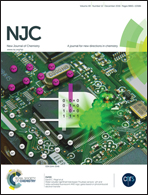Molecular diversity in several pyridyl based Cu(ii) complexes: biophysical interaction and redox triggered fluorescence switch†
Abstract
Variation of pyridyl based receptors around a Cu(II) center results in structural diversity allowing redox triggered Cu(II)/Cu(I) fluorescence switch for intracellular Cu(I) imaging. Single crystal X-ray structures of 2-hydroxy-6-methylnicotinic acid (L1), its mono nuclear Cu(II) complex, viz. [Cu(L1)2(H2O)(SO4)]·2H2O (C1a), polymeric Cu(II) complex (C1b) and a dinuclear Cu(II) complex of 2-(naphthalen-2-ylmethylsulfanyl)-nicotinic acid (L4), viz. [Cu2(L4)4(H2O)2]·1.12H2O (C4) with a Cu–Cu distance of 2.6028(7) Å are reported. Moreover, C1a interacts with calf thymus DNA, which is useful for disruption of normal DNA activity with plausible applications in biology (binding constant, K′ = 1.56 × 104). Chemical or electrochemical reduction of C1a generates a fluorescent Cu(I) complex. The lowest detection limit of L1 for Cu(I) is 50 μM. The association constant of L1 for Cu+ is 7.09 × 102. Quenching constants of Cu(II) for L1, L2, L3 and L4 are 4 × 105, 4.2 × 106, 8.9 × 105 and 4.4 × 106, respectively. The magnetic behavior of C1b indicates a ferromagnetic one-dimensional solid.



 Please wait while we load your content...
Please wait while we load your content...